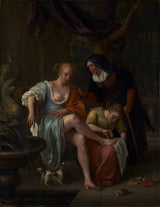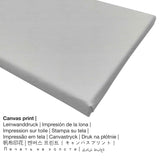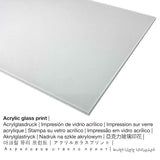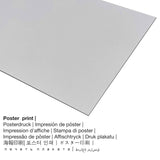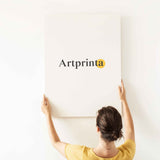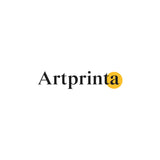Jan Steen, 1675 - Batsheba mgbe ịsa ahụ gasịrị - mbipụta nka mara mma
Ụtụ gụnyere. Mbupu gbakọrọ na ndenye ọpụpụ.
Họrọ ihe ị chọrọ
For every fine art print we offer a range of different materials & sizes. Pick your favorite material and size between the preferences:
- Mbipụta akwụkwọ mmado (akwa akwa akwa): Our poster is a UV printed canvas paper with a slightly rough surface texture, that reminds the actual masterpiece. A poster is optimally suited for framing your art replica with the help of a custom-made frame. Please keep in mind, that depending on the absolute size of the canvas poster print we add a white margin of around 2 - 6cm around the painting, which facilitates the framing with your custom frame.
- Bipụta na iko acrylic (nke nwere ezigbo mkpuchi iko): The print on acrylic glass, which is sometimes denoted as a print on plexiglass, makes the artwork into gorgeous décor. Your work of art is being manufactured thanks to modern UV printing machines.
- Aluminom ihe eji eme ihe: An Aluminium Dibond print is a print with an outstanding depth. A direct Aluminium Dibond Print is the perfect introduction to fine art replicas on alu. The bright and white parts of the original work of art shine with a silk gloss but without any glow. The colors are luminous in the highest definition, the fine details of the print appear clear and crisp, and you can notice a matte appearance of the fine art print. The direct print on aluminium is one of the most demanded entry-level products and is an extremely contemporary way to showcase artworks, as it puts the viewer’s attention on the image.
- Mbipụta kwaaji: A canvas print is a printed canvas stretched on a wooden stretcher. A canvas of your favorite artwork will allow you to transform your fine art print into a large size artpiece as you would see in a gallery. Canvas prints are relatively low in weight, which means that it is easy and straightforward to hang your Canvas print without the support of any wall-mounts. A canvas print is suited for any kind of wall.
Nkwupụta iwu: We try what we can in order to depict our products as closely as possible and to illustrate them visually in our shop. Still, the colors of the printing material, as well as the print result can diverge to a certain extent from the representation on the device's monitor. Depending on your screen settings and the condition of the surface, color pigments may not be printed 100% realistically. Bearing in mind that all the art prints are processed and printed manually, there may as well be slight deviations in the motif's size and exact position.
Original artwork description as provided from The J. Paul Getty Museum website (© - Ụlọ ihe ngosi nka nke J. Paul Getty - Ụlọ ihe ngosi nka nke J. Paul Getty)
Bathsheba stares brazenly out at the viewer while a maidservant trims her toenails. King David, who saw her beauty and desired her, sent her a summons to appear at his palace. Although she was married, Bathsheba was forced to comply.
A popular subject, artists often portrayed Bathsheba as distraught about her dilemma. Here, Jan Steen depicted her as a temptress, rather than the innocent victim of the king's passion. In this moralizing painting, Steen commented on the foolishness of human behavior.
Bathsheba's robe is casually arranged to reveal her breast and bare legs. The shoe in the right foreground symbolizes lasciviousness; the fountain on the left probably alludes to female fecundity. She is so lost in her thoughts that she holds King David's note loosely in her right hand and pays no attention to the small dog or to the old woman grasping her shoulder.
Nkọwa ngwaahịa izugbe
Bathsheba after the Bath was made by the baroque Dutch painter Jan Steen. Besides, this work of art is included in the digital art collection of Ụlọ ihe ngosi nka nke J. Paul Getty in Los Angeles, California, Njikota Obodo Amerika. Nke a kpochapụwo nkà ọrụ nka, nke bụ nke ngalaba ọha a na-enye ya site n'ikike nke Ụlọ ihe ngosi nka nke J. Paul Getty.Ebe E Si Nweta nke ihe osise:. Ndozi n'ime Eserese format and has an image ratio of 3 : 4, meaning that the length is 25% shorter than the width. Jan Steen was a male painter, whose artistic style was primarily Baroque. The Dutch artist lived for 53 afọ and was born in 1626 in Alkmaar, North Holland, Netherlands and deceased in the year 1679 in Alkmaar, North Holland, Netherlands.
Data ndabere gbasara nka
| Aha nka nka: | "Bathsheba after the Bath" |
| nhazi ọkwa: | sere |
| Nhazi nka: | nka ochie |
| Century: | 17th narị afọ |
| Afọ nka: | 1675 |
| Afọ nka: | karịa afọ 340 |
| Ụlọ ihe ngosi nka / mkpokọta: | Ụlọ ihe ngosi nka nke J. Paul Getty |
| Ebe ngosi nka: | Los Angeles, California, Njikota Obodo Amerika |
| Weebụsaịtị nke ihe ngosi nka: | Ụlọ ihe ngosi nka nke J. Paul Getty |
| Akwụkwọ ikike nka: | ngalaba ọha |
| Site n'aka: | Ụlọ ihe ngosi nka nke J. Paul Getty |
Ozi ngwaahịa ahaziri
| Ụdị ngwaahịa: | nka nka |
| Usoro mmeghari: | dijitalụ mmeputakwa |
| Produzọ mmepụta: | Mbipụta UV / dijitalụ |
| Ihe ngosi: | arụpụtara na Germany |
| Stockdị ngwaahịa: | na mmepụta ihe |
| Ojiji ngwaahịa: | mgbidi gallery, ime ụlọ |
| Ntuziaka onyonyo: | nhazi ihe osise |
| Oke akụkụ: | (ogologo: obosara) 3: 4 |
| Ntụgharị nkọwa akụkụ onyonyo: | ogologo bụ 25% mkpụmkpụ karịa obosara |
| Nhọrọ ihe: | mbipụta ọla (aluminium dibond), mbipụta akwụkwọ mmado (akwụkwọ kwaaji), mbipụta kanvas, mbipụta iko acrylic (nwere ezigbo mkpuchi iko) |
| Mpempe akwa akwa (akwa akwa na etiti ihe ndọtị) nha: | 30x40cm - 12x16", 60x80cm - 24x31", 90x120cm - 35x47", 120x160cm - 47x63" |
| Mpempe iko acrylic (nwere ezigbo mkpuchi iko) nha dị iche iche: | 30x40cm - 12x16", 60x80cm - 24x31", 90x120cm - 35x47", 120x160cm - 47x63" |
| Mpempe akwụkwọ mmado (akwụkwọ kwaaji) nha: | 30x40cm - 12x16", 60x80cm - 24x31", 90x120cm - 35x47" |
| Mbipụta aluminom: | 30x40cm - 12x16", 60x80cm - 24x31", 90x120cm - 35x47" |
| ụba: | na-enweghị etiti |
Tebụl nyocha nke onye na-ese ihe
| aha: | Jan Steen |
| Aliases: | Steen Jan 'de Alkmaarsche, Jan Steen, Steen Jan, Jan Steen de Alkmaarsche, Jan Steen de Alkmaarsche |
| okike nke onye nka: | nwoke |
| Obodo onye nka: | Dutch |
| Ọrụ: | onye na-ese ihe |
| Obodo onye nka: | mba netherland |
| Nhazi nke onye nka: | nna ukwu ochie |
| styles: | Baroque |
| Nwụrụ na afọ nke: | 53 afọ |
| A mụrụ: | 1626 |
| Ebe amụrụ onye: | Alkmaar, North Holland, Netherlands |
| Afọ nwụrụ: | 1679 |
| Nwuru na (ebe): | Alkmaar, North Holland, Netherlands |
Enwere ikike nwebiisinka ©, Artprinta (www.artprinta.com)

